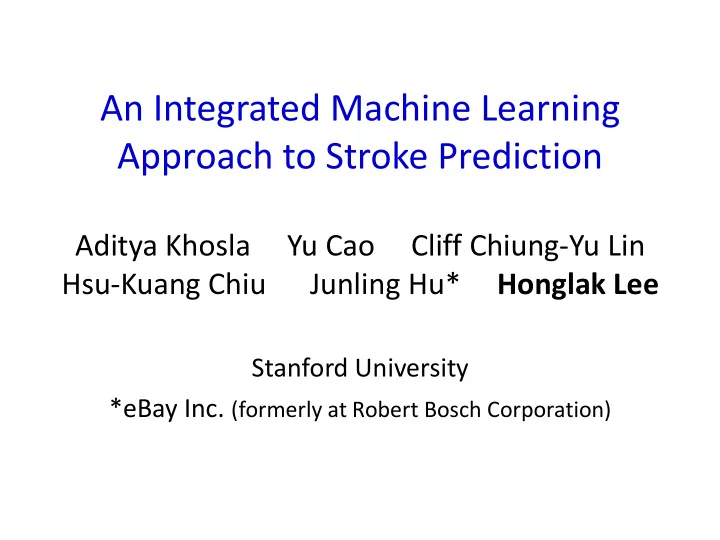

An Integrated Machine Learning Approach to Stroke Prediction Aditya Khosla Yu Cao Cliff Chiung-Yu Lin Hsu-Kuang Chiu Junling Hu* Honglak Lee Stanford University *eBay Inc. (formerly at Robert Bosch Corporation)
Outline Motivation Our Approach Data imputation, feature selection, and prediction A new algorithm for feature selection A new algorithm for prediction Experimental Results Summary
Motivation
Importance of stroke prediction The third leading cause of death in the US 137,000 die from stroke each year. Leading cause of long-term disability in the US Risk factors need to be discovered. Current research on stroke is on simple statistical models. Our goal: Bring machine learning methods to stroke prediction.
Identifying risk factors Mostly based on clinical studies Known risk factors Physical: E.g.: Age, prior stroke, blood pressure, hypertension, time to walk 15 feet, cardiac injury score, diabetic status, atrial fibrillation, left ventricular mass, etc. Behavioral: E.g.: cigarette smoking, poor diet, alcohol abuse, etc.
Existing stroke prediction models Cox proportional hazards model One of the most commonly used statistical methods in medical research Applied to prediction of various diseases Hazard function at time t T ( | ; ) ( ) exp( ) h t h t x x 0 : input features for an individual x : timing of stroke t : parameters of the model
Previous approaches Related work on stroke prediction Lumley et al. (2002), Manolio et al. (1996); Longstreth et al. (2001); Chambless et al. (2004); : Hitman et al. (2007), etc. Limitations Use limited number of features Manually selected Small size (< 20) Limited modeling methods Most used Cox proportional hazards regression Not utilizing modern machine learning methods
Our Approach
Existing approaches vs. Our approach Existing approaches Our approach Number of features ~ 20 ~ 1000 Manually selected Automatic feature selection Feature selection (e.g., L1 logistic regression) Cox proportional Machine learning methods Prediction algorithm hazards model (e.g., SVM) Examples of existing approaches: Lumley et al. (2002); Manolio et al. (1996); Longstreth et al. (2001); Chambless et al. (2004); : Hitman et al. (2007), etc.
Overview of our approach Data Feature Prediction Imputation selection “Mean” L1 logistic SVM “Median” Margin-based regression Linear Conservative Censored regression mean feature regression … … selection …
Our methods We evaluated several missing value imputation methods Mean, median, linear regression, EM. We evaluated several feature selection methods Forward feature selection L1-regularized logistic regression Conservative Mean feature selection (this paper) • We evaluated several prediction methods SVM ( SVM-perf to directly optimize the AUC) Margin-based Censored regression (this paper)
Feature selection: Conservative Mean For each feature j , divide the training data into N folds and compute: k : Area under the ROC curve for fold AUC k N 1 k AUC j N 1 k 1 N 2 k ( ) AUC j j N 1 k Use for ranking the features (i.e., j j more “conservative” estimate than ). j Details in the paper.
Margin-based Censored Regression (MCR) Prediction function z Want to learn: z ~ w T x Censored regression x 0 Want to predict timing of stroke only if it happens margin within a given timeframe. “Margin - based” x: features If stroke does not happen, z: “inverse” of stroke timing t z > 0: stroke happened we want to predict it as z ≤ 0: stroke did not happen “negative” with a margin.
Optimization problem for MCR We solve the following optimization problem: regression error classification error for for stroke events “non - stroke” cases margin constraints
Experimental results
Experimental setup Cardiovascular Heart Study (CHS) data Annual examinations for elderly people (+65 years) Study conducted from 1989 for 10+ years After preprocessing, we have 796 features, 4988 examples (299 positives/ 4689 negatives) Our task Use baseline (first year) measurement as features and perform 5 year prediction Train over 9/10 of data and test on 1/10 of data (random split and repeat 5 times).
Results – missing data imputation Used Conservative Mean for feature selection and SVM for prediction. For each missing value, substituting with the median (over the observed feature values) performed the best Imputation Method Test AUC Column Median 0.774 Linear Regression (with rounding) 0.768 Regularized EM 0.765 Column Mean (with rounding) 0.765
Prediction results - AUC Best performance achieved using Conservative mean + MCR 15% error reduction over Lumley et al.’s method Test AUC Prediction algorithm Feature selection algorithm SVM MCR Conservative Mean 0.774 0.777 L1 logistic regression 0.764 0.771 Manually selected 16 features* 0.753 0.765 Baseline: Cox + 16 features*: 0.734 * used in Lumley et al. (2002)
Prediction results – Concordance Index Similar results as AUC Test Concordance Index Prediction algorithm Feature selection algorithm SVM MCR Conservative Mean 0.760 0.770 Manually selected 16 features* 0.747 0.757 Baseline: Cox + 16 features*: 0.730 * used in Lumley et al. (2002)
Discovering potential risk factors Top features selected by our algorithm from a set of 796 features (or measurements) Description Score Age 0.606 Number of symbols correctly coded* 0.583 Maximal inflation level* 0.582 Systolic blood pressure 0.574 Calculated 100 point score* 0.568 Total medications* 0.563 Isolated systolic hypertension 0.559 General health* 0.552 Calculated hypertension status 0.550 Time (in sec) to walk 15 feet 0.549 * These represent newly discovered potential risk factors.
Summary Integrated approach to stroke prediction Imputation, feature selection, and prediction Novel feature selection/prediction algorithms Conservative Mean feature selection Margin-based Censored Regression Outperform the existing methods Discovery of new potential risk factors
Thank you!
Recommend
More recommend